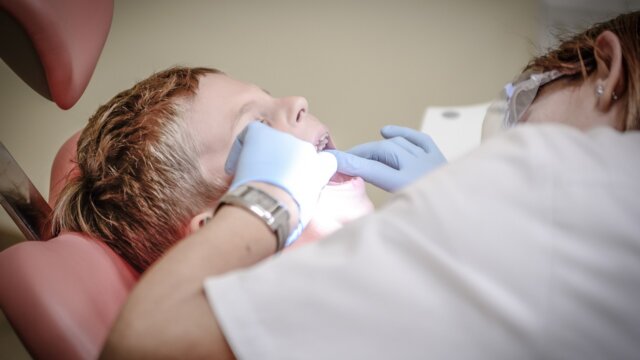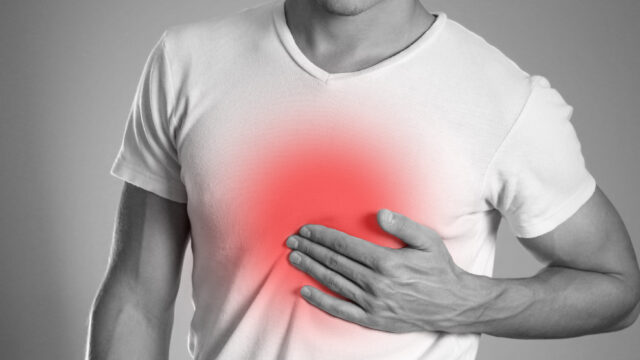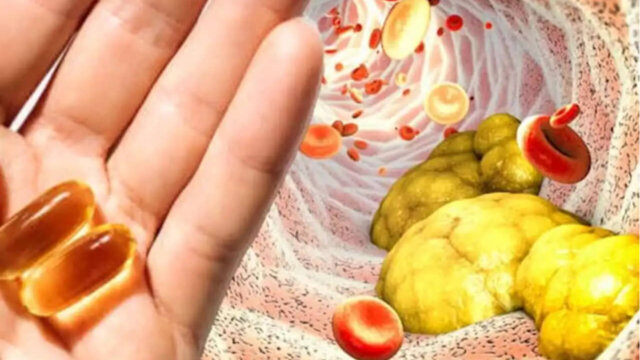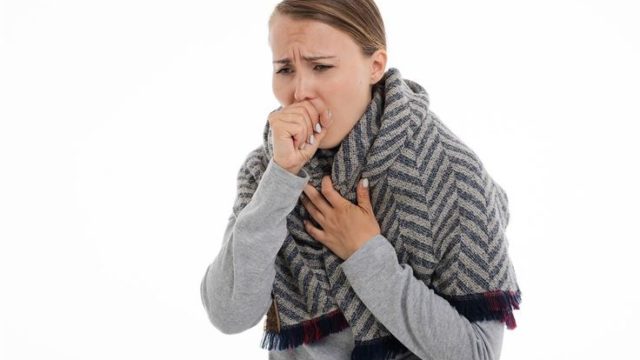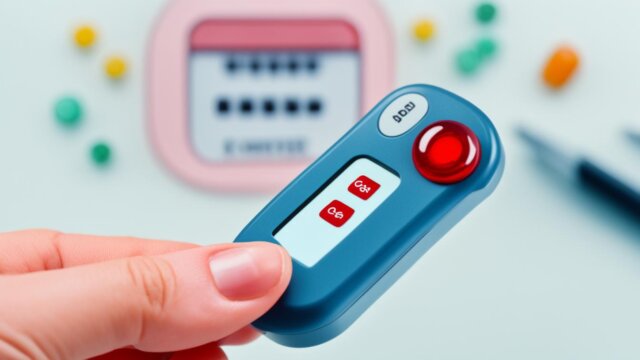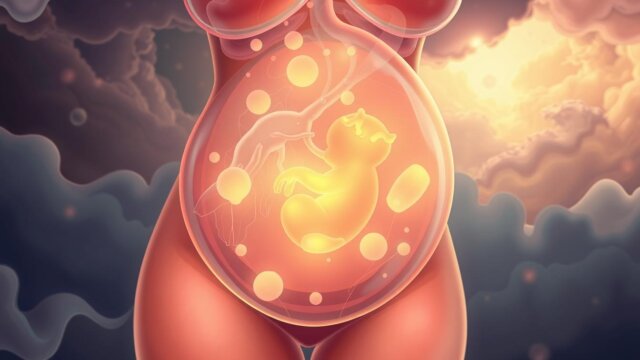FTC disclaimer: This post may contains affiliate links and we will be compensated if you click on a link and make a purchase.
Acute lymphoblastic leukemia (ALL) is the most common cancer in kids. It makes up about 2 percent of lymphoid neoplasms in the U.S.. It usually hits kids between two and ten years old.
This fast-growing cancer needs quick treatment to go into remission. Knowing about ALL’s causes, symptoms, diagnosis, and treatments is key to managing it.
ALL is more common in boys than girls and in Caucasians than African Americans. It affects about 4,000 people in the U.S. each year, mostly kids. The chance of getting ALL is about 3.3 cases per 100,000 kids.
But, the good news is that survival rates have jumped up since the 1980s. Now, more than 85 percent of patients live for five years or more.
Key Takeaways
- Acute lymphoblastic leukemia (ALL) is the most common type of cancer in children.
- ALL is a fast-growing cancer of the blood and bone marrow that requires prompt treatment.
- ALL occurs more frequently in males and Caucasians compared to females and African Americans.
- The incidence of ALL is around 3.3 cases per 100,000 children.
- Survival rates for ALL have dramatically improved, with a current five-year overall survival rate of over 85 percent.
What is Acute Lymphoblastic Leukemia?
Acute lymphoblastic leukemia (ALL) is a blood cancer. It starts in the bone marrow, where blood cells are made. The bone marrow makes bad white blood cells called lymphoblasts that grow fast.
This is different from chronic leukemia, which grows slower.
Acute vs. Chronic Leukemia
ALL is an acute leukemia. It grows fast and can be deadly in a few months without treatment. Chronic leukemias grow slower over time.
Lymphocytic vs. Myeloid Leukemia
ALL is a lymphocytic leukemia. It affects lymphoid cells, like lymphocytes. Lymphocytes help fight infections.
Lymphoblasts in ALL grow fast. They can take over healthy blood cells, causing big problems if not treated. Knowing the differences helps doctors diagnose and treat ALL better.
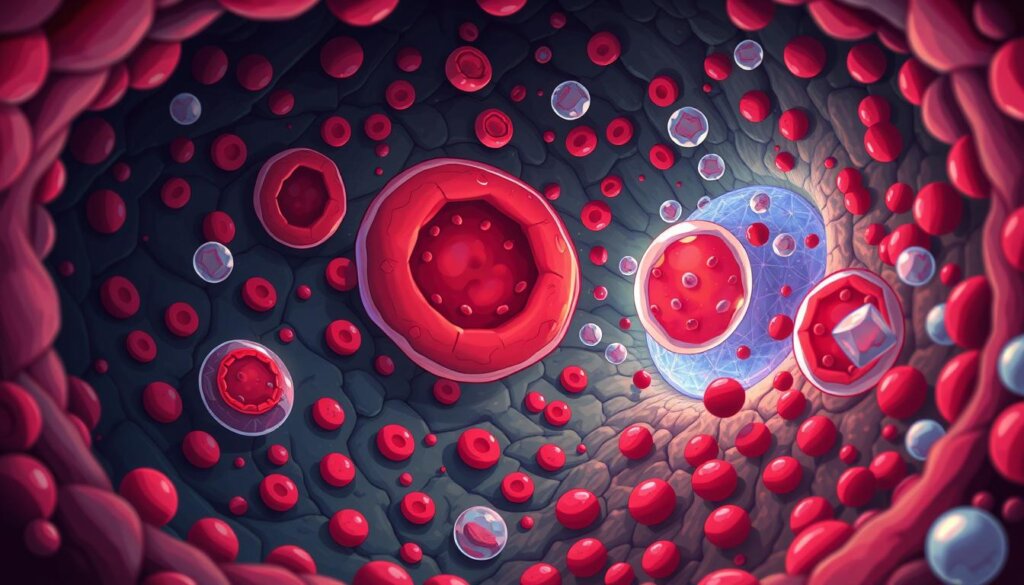
“Acute lymphoblastic leukemia (ALL) is the most common type of cancer in children.”
Causes and Risk Factors
The exact causes of acute lymphoblastic leukemia (ALL) are still a mystery. But, we know genetic mutations and DNA changes in blood cells are key. Some risk factors can make it more likely for someone to get ALL.
Genetic Mutations and DNA Changes
Genetic changes in blood cells can cause ALL. These changes can be passed down or happen because of things like cancer treatment or radiation.
Previous Cancer Treatment
People who had cancer treatment before might get ALL later. This risk is higher for AML than ALL.
Radiation Exposure
High radiation can raise the risk of ALL and AML. Those who had radiation for other cancers might be at higher risk.
Genetic Disorders
Genetic conditions like Down syndrome increase ALL risk. These conditions can cause genetic changes that lead to leukemia. Having a twin with ALL also raises the risk.
Even with these risk factors, not everyone will get ALL. More research is needed to understand how genetics, environment, and lifestyle affect ALL.
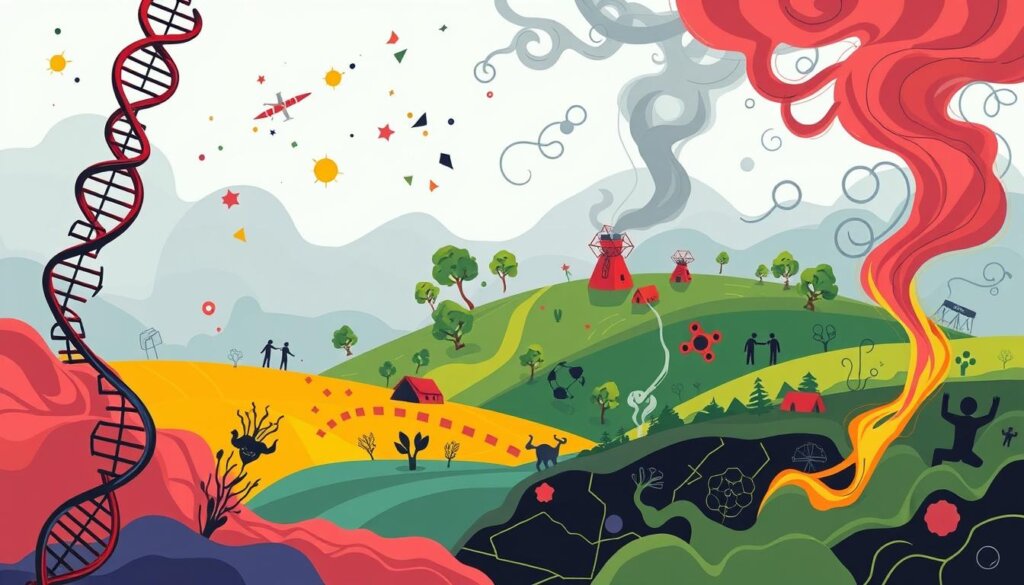
Signs and Symptoms
When acute lymphoblastic leukemia (ALL) starts, it crowds out healthy blood cells. This leads to signs and symptoms. You might notice easy bruising or bleeding, fatigue, and weakness. Also, you could get sick often and have swollen lymph nodes.
Fever is another symptom as your body tries to fight off infections.
Bleeding and Bruising
Low blood cell numbers can cause fatigue, weakness, and dizziness. You might also feel short of breath or have pale skin. Other signs include frequent infections, skin bruising, and bleeding issues like nosebleeds.
Fatigue and Weakness
ALL can make you lose weight, feel feverish, and have night sweats. You might also lose your appetite. The liver and spleen can swell, causing discomfort after eating.
Fever and Infections
Frequent infections happen because your immune system is weak. In rare cases, ALL can spread to organs. This causes symptoms specific to each organ.
Swollen Lymph Nodes
Swollen lymph nodes can be felt as lumps under the skin. They often appear in the neck, groin, or underarms. Lymph nodes inside the chest or abdomen might need imaging tests to find.
Bone or joint pain can occur when leukemia cells gather near bones or joints.
In rare cases, T-cell ALL can make the thymus swell. This can cause coughing or breathing problems. An enlarged thymus can also press on the SVC, leading to serious symptoms like swelling and headaches.
The symptoms of ALL can appear quickly and might seem like the flu. It’s important to recognize these symptoms early for timely treatment.

Diagnostic Procedure | Description |
|---|---|
Bone Marrow Aspiration and Biopsy | Involves removing about 2 teaspoons of bone marrow for examination. |
Lumbar Puncture (Spinal Tap) | Involves removing the fluid that surrounds the brain and spinal cord for examination. |
Chest X-ray | Taken to detect a mass of cells in the thymus, impacting breathing. |
“Leukemia is the most common type of cancer in children, and acute lymphoblastic leukemia (ALL) is the most common type of leukemia in children. Most kids and teens treated for leukemia are cured of the disease.”
Acute Lymphoblastic Leukemia
Acute lymphoblastic leukemia (ALL) is a blood cancer that starts in the bone marrow. This is the spongy tissue inside bones where new blood cells are made. In ALL, the bone marrow makes bad white blood cells called lymphoblasts. These cells take over and stop healthy cells from working.
These young lymphoblasts can’t do their job right. This leads to big health problems if not treated.
ALL is the most common cancer in kids, but it can also hit adults. Signs of ALL include feeling weak, having a fever, bruising easily, losing weight, and swollen lymph nodes. To treat ALL, doctors use a mix of chemotherapy, radiation, stem cell transplants, and targeted therapy.
Treatment for ALL has two parts: killing leukemia cells and keeping them from coming back. They also use special therapy to stop leukemia from spreading to the brain and spinal cord. Scientists are always looking for new ways to treat ALL and make patients’ lives better.
Risk Factors for Acute Lymphoblastic Leukemia | Diagnostic Tests for Acute Lymphoblastic Leukemia |
|---|---|
|
|
It’s key to know how ALL works and how it starts to manage it well. Past treatments and radiation can raise your risk of getting ALL. Tests like blood work, bone marrow checks, and scans help doctors find and understand ALL.
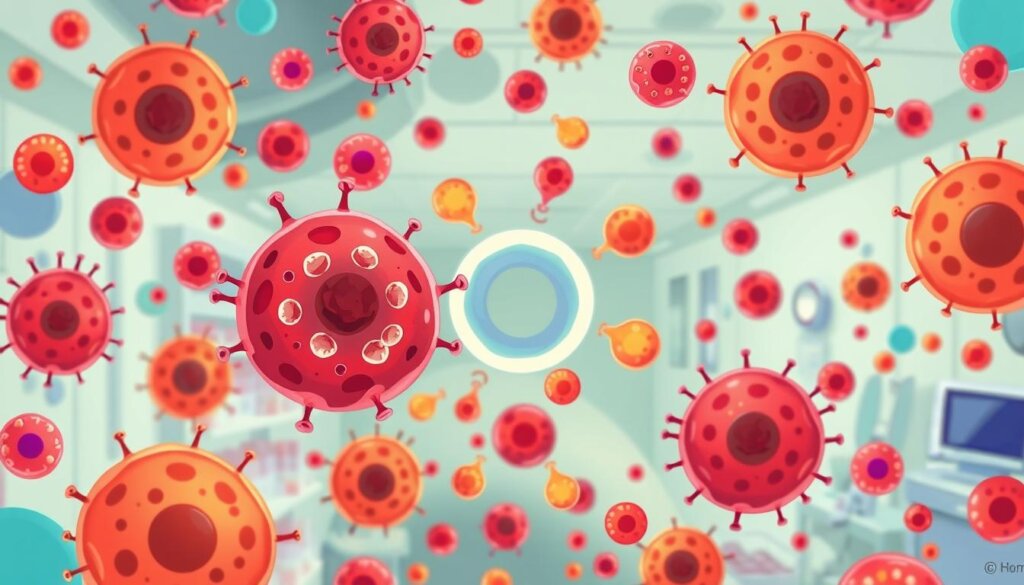
“Ongoing research in ALL is focused on identifying new treatment options and improving patient outcomes.”
Diagnosis and Testing
Diagnosing acute lymphoblastic leukemia (ALL) is key to finding the right treatment. It involves blood tests and a bone marrow aspiration and biopsy. These tests check for the disease and its type.
Blood Tests
Blood tests are vital in diagnosing ALL. They look for abnormal blood cells and blast cells. Blast cells are immature and grow fast, a sign of ALL.
Bone Marrow Aspiration and Biopsy
A bone marrow test is needed to confirm ALL. A small bone marrow sample is taken from the hipbone. It’s checked for lymphoblasts, the abnormal cells of ALL.
At times, a spinal tap is done to check the brain for leukemia cells. Imaging tests like X-rays or CT scans also help see if the cancer has spread.
Diagnostic Test | Purpose |
|---|---|
Blood Tests | Detect abnormal blood cell counts and the presence of blast cells |
Bone Marrow Aspiration and Biopsy | Confirm the diagnosis of ALL and assess the characteristics of the cancer cells |
Lumbar Puncture (Spinal Tap) | Check for the presence of leukemia cells in the central nervous system |
Imaging Tests (X-rays, CT Scans) | Determine if the cancer has spread to other parts of the body |
These tests give doctors the info they need to plan treatment for ALL.
Treatment Options
The main treatment for acute lymphoblastic leukemia (ALL) is chemotherapy. It aims to kill bad cells and make healthy blood cells again. Radiation therapy might also be used to stop cancer in the brain. Sometimes, a stem cell transplantation is needed to fix the immune system after strong chemotherapy.
Chemotherapy
Chemotherapy for ALL has three parts: induction, consolidation, and maintenance. Treatment usually lasts about 2 years, with most time spent on maintenance. About 80% to 90% of adults with ALL get better during treatment. But, about 50% of them might have the cancer come back, making the cure rate around 40%.
Radiation Therapy
Radiation therapy helps stop central nervous system involvement in ALL. It’s key for those with high-risk features or who don’t respond well to first treatments.
Stem Cell Transplantation
For some, a stem cell transplant is suggested for refractory or relapsed ALL. This uses healthy stem cells to fix the immune system after strong chemotherapy. It’s a good option for those with high-risk features or who didn’t do well with first treatments.
The treatment plan for ALL depends on the disease type, age, health, and how well the first therapy works. It’s important to keep up with follow-up care and support during treatment.
“Prognosis and treatment outcomes can vary significantly depending on the subtype of ALL and individual response to therapy.”
Pediatric ALL and Adult ALL
Acute lymphoblastic leukemia (ALL) is a cancer that can hit both kids and grown-ups. It shows up differently and needs special treatments. Kids’ ALL makes up about 25% of all childhood cancers in the U.S. It mostly hits kids aged 1 to 4 years. Adult ALL is rarer and has a lower survival rate, but treatments have gotten better.
Kids with ALL have a good chance of getting better, with survival rates over 85% for those under 15. But, for adults, the survival rate is only 30-40% for those over 40. This difference is because of how the disease acts differently in kids and grown-ups.
Genes are key in kids’ ALL. Down syndrome and other genetic conditions can raise the risk of childhood ALL. X-rays before birth, radiation, and past chemo treatments are also risk factors.
Treatments for kids and adults with ALL are different because of age. Survival rates drop sharply after age 17-20, with rates of 75% at 17, 48% at 20, and 15% at 70. Tailoring treatments to each age group is key to better care for ALL patients.
Age Group | ALL Survival Rates |
|---|---|
Children under 15 years old | Over 85% |
Adults over 40 years old | 30-40% |
Managing kids’ and adults’ ALL also varies by genetic subtype. For example, the ETV6-RUNX1 subtype is common in kids and has a good outlook. But, the BCR-ABL1 subtype is more common in adults and has been tough to treat. Knowing these differences helps doctors make better treatment plans.
“Understanding the unique characteristics and management strategies for pediatric and adult ALL is crucial for providing the most effective care.”
In summary, treating kids’ and adults’ ALL needs a personalized approach. By understanding the differences in the disease, doctors can offer better care for each age group.
Prognosis and Survival Rates
The outlook for acute lymphoblastic leukemia (ALL) varies a lot. The National Cancer Institute says about 6,150 new cases will be found this year in the United States. This shows how important it is to know about the disease’s outlook.
Factors Affecting Prognosis
Age is a big factor in how well someone does with ALL. It’s more common in kids and young adults, who tend to do better. It’s also more common in people under 15 or over 45, and the risk goes up at 45 for adults.
What type of ALL it is, genetic changes like the Philadelphia chromosome (found in 20-30% of cases), and how well treatment works are also key. These all play a big role in how well someone will do.
ALL is one of the top five cancers in adults over 20. The five-year survival rate for ALL is 71.3 percent. But, this rate goes down as people get older.
Prognostic Factor | Impact on Prognosis |
|---|---|
Age | Younger patients have a higher survival rate compared to older adults |
Genetic Abnormalities | Presence of the Philadelphia chromosome is associated with a poorer prognosis |
Response to Treatment | Patients who respond well to initial chemotherapy have better outcomes |
Knowing these important factors helps doctors choose the best treatment. For adults, chemotherapy is often the main treatment, leading to better results. Other treatments like intrathecal chemotherapy, high-dose drugs, radiation, and stem cell transplants are also used.
“The prognosis for children with ALL is generally more favorable, with long-term survival rates around 90%. However, the prognosis for adults with ALL is less optimistic, with 5-year survival rates ranging from 30% to 70%, depending on risk factors.”
Getting a full check-up from a doctor who knows your medical history is key. They can give a good idea of what to expect and the best treatment plan for ALL.
Living with ALL
If you’ve been diagnosed with acute lymphoblastic leukemia (ALL), you may need a lot of supportive care. This care helps manage treatment side effects and keeps you healthy. It includes preventing infections, managing pain, and offering emotional support. Also, regular check-ups are key to watch for disease return and manage treatment effects.
Supportive Care
Your GP is very important in your ongoing care. They help you get the support you need outside of the hospital. Community nurses may also help with your care, giving medicines and emotional support.
Special nurses, like Macmillan nurses, focus on pain and symptoms. Social workers help with home support and benefits. Local groups offer practical help and information.
Follow-up Care
Treatment for ALL lasts at least 2 years. After treatment, you’ll need regular check-ups for years. Relapse can happen during or right after treatment, but it’s rare after 5 years.
Your survivorship care plan will include follow-up schedules and health tips. Healthy habits like not smoking and eating well can help. Emotional support from loved ones and groups is also very important.
“The journey of living with ALL is not an easy one, but with comprehensive supportive and follow-up care, you can improve your quality of life and increase your chances of achieving and maintaining remission.”
Prevention and Early Detection
There’s no known way to prevent acute lymphoblastic leukemia. But catching it early is key to better outcomes. Regular doctor visits, especially for those at risk, help find and treat it fast.
Research is ongoing to understand ALL’s causes. This might lead to better ways to prevent it. For now, focusing on early detection is the best strategy. Quick diagnosis and treatment can greatly improve survival chances.
Screening for those at higher risk of ALL is a potential early detection method. Right now, only some genetic conditions, like Down syndrome, can be screened. More research could lead to screening for more risk factors in the future.
“Early detection and prompt treatment are key to improving outcomes for individuals with acute lymphoblastic leukemia.”
Regular check-ups and watching for symptoms are important. They help catch ALL early. Working with doctors, people can help find and treat the disease early.
Preventing ALL is hard, but early detection is crucial. Being informed and proactive about health is vital in the fight against leukemia.
Conclusion
Acute lymphoblastic leukemia (ALL) is a serious blood cancer that needs quick medical help and full treatment. It affects over 6,500 people in the United States each year. Knowing about ALL’s causes, signs, diagnosis, and treatments is key for those with it.
Even though many people respond well to first treatments, staying in remission long-term is hard. Only 30-40% of adults can survive long-term. But, research and better care, like using genetic tests, are helping. This is especially true for kids with ALL, thanks to the Children’s Oncology Group’s work.
As doctors learn more about ALL’s genetics and changes in genes, treatments will keep getting better. People with ALL can fight this disease by knowing a lot and being involved in their care. This way, they can aim for the best results.

